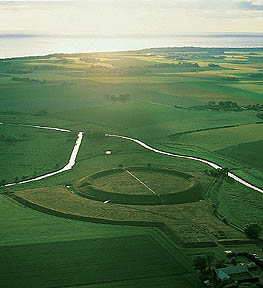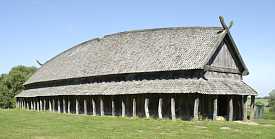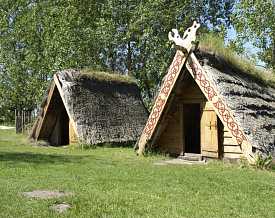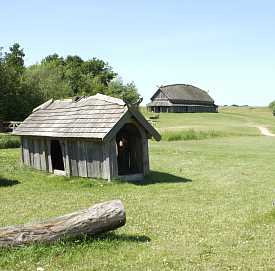|

Seen
from the air it is clear to see the perfect cirkular shape of
Trelleborg. Photo: Jan Winther / Visit Denmark
|
Trelleborg
is probably the most well known of the large circular fortresses.
The reason being, among others, that it was the first one to be
recognized. Although the circular rampart had been known
throughout the ages, little energy had been invested in figuring
out its purpose. Only when a motorcycle club began making plans
for turning the circular rampart into a speedway-track did the
National Museum put its foot down and started excavating the site
in 1933.
|

The
longhouse of Trelleborg
|
The
excavations of the other circular fortresses of Aggersborg,
Fyrkat, Nonnebakken in Odense, and Trelleborg of Scania (Sweden)
were only initiated after the discovery of the Danish Trelleborg.
The
fortress itself stands somewhat barren in the landscape, and is
actually best seen from an aeroplane, but in connection to the
fortress, a museum was built in 1995, and the small Viking village
of Trelletorp - which is the setting of various activities during
summer - is continuously expanded.
|

The
small houses of Trelletorp
|
At
an early stage, one of the great longhouses was reconstructed,
originally situated inside the large ramparts. However, much new
knowledge has been gathered on the construction of these halls,
and it is commonly agreed that the reconstruction at Fyrkat near
the town of Hobro is closer to the original. The most obvious
difference is that the posts surrounding the house are placed
diagonally on the Fyrkat house, while they are vertical on the
Trelleborg house.
|

The
museum put a lot of effort in making Trelleborg a good place for
children. In front a small version of the great longhouse in the
background.
|
The
fortress of Trelleborg was not in active use as a fortress for
long, following its construction around AD 980. Still, a large
number of artefacts and warriors’ graves were found here, the
majority of which is on display at the Museum, which has recently
opened a thoroughly re-designed exhibition hall. The museum also
has developed the small reconstructed village Trelletorp which is
used to show living history.
The
fortress of Trelleborg is situated a few kilometers west of the
town of Slagelse, and there is access to the ramparts at all
times. By car there is easy access from highway E20. Leave the
highway at entry no 40 Slagelse V following route 150
towards Slagelse. After ca 2 kilometers go left on a minor road
towards Hejninge. Follow the signs from there.
Via
publich transport it is possible to take a bus from Slagelse which
can be reached by intercity train from Copenhagen.
The
museum is open April to October. Monday closed. A
wide range of activities take place at Trelleborg during summer.
Trelleborg
is noted for hosting a week long Viking Fair of Denmark in July and
arranging a reconstruction of The Battle of Trelleborg when Harald
Bluetooth and his son Svend Forbeard fighted about the power of
Denmark.
The
Viking fortress of Trelleborg
Trelleborg Allé 4
Hejninge
4200 Slagelse
phone (+45) 58 54 95 06
Homepage: en.natmus.dk/museums-and-palaces/trelleborg/
|